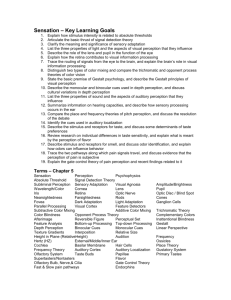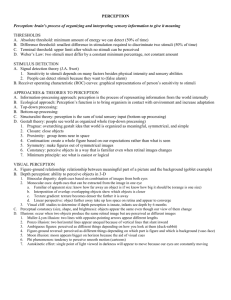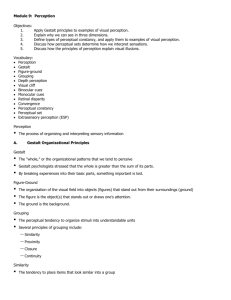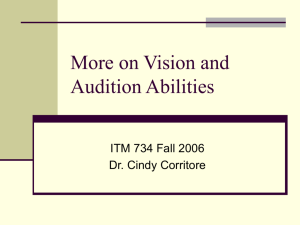perception
advertisement
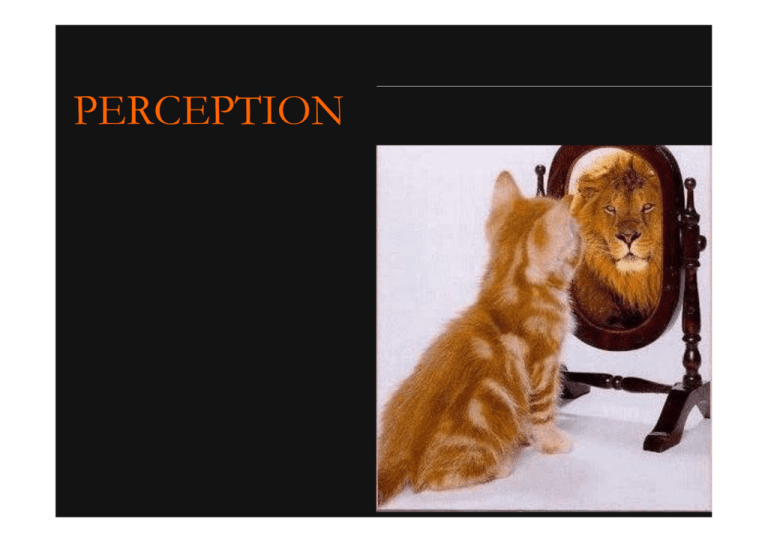
PERCEPTION Sensation vs. Perception • What’s the difference? – Sensation Æ what the senses do – Perception Æ process of recognizing, organizing andd interpreting i t ti information. i f ti What is Sensation? • The process whereby the h physical h i l iinput ffrom the environment is coded d d into i neurall responses What is Perception? • The way in which you i interpret or iinternally ll represent incoming sensations. i Proximal vs. Distal • Distal Stimulus: – Actual stimulus as it is in our environment • a plane p • Proximal Stimulus: – The Th representation i off the h stimulus i l iin our system. • light reflected from the plane that falls on our retina Perception: Basics • • • • Shape Constancy Size Constancy Depth Perception Perceptual Organization Shape Constancy • Perception of the stimulus stays constant even though the g sensation changes. Size Constancy Depth Perception • How do we perceive depth? • Some cues help us: – Pictorial Cues • • • • Interposition Si Size Texture gradient Li Linear perspective i – Motion Cues – Binocular Cues Interposition • When one object blocks the other,, we see the blocked object as further away. y Relative Size • The smaller object is perceived as further away Texture Gradients As the surface ggets farther away from us this texture gets finer and appears smoother h Linear Perspective Parallel lines that recede into the distance appear to get closer together or converge. Motion Parallax ¾As we move, move objects that are closer to us move farther across our field of view than do objects that are in the distance. Movement Cues ¾F Focus on an object bj t att an intermediate i t di t distance. di t Things Thi closer to you than the focused object will appear to move in the opposite direction of your head movement whereas things farther away from you than the focused object will appear to move in the same direction as your head movement. Binocular Cues ¾Binocular disparity - The eyes are offset by about 6 cm. creating two slightly different views of the g combine to form a 3-D world. The images scene Retinal Disparity ¾ The difference between the images of an object seen by left and right g eyes y resultingg from the eyes' y horizontal separation. p Organization in Visual Perception • Gestalt Psychology – Humans have a tendency to see patterns rather than random arrangements g • exp: clouds, wallpapers, mosaic flooring… – We tend to organize what we see. The Law of Pragnanz g Gestalt Laws w of Grouping p g – Proximity Po ty – Similarity – Good continuation – Closure – Common fate Gestalt Laws of Grouping • Proximity - Objects near each other tend to be processed as a unit. Gestalt Laws of Grouping • Similarity - Objects similar to each other tend d to b be processed d as a unit. i Gestalt Laws of Grouping Gestalt Laws of Grouping • Good continuation - Objects j arranged g in a straight line or curve tend to be seen as a unit. Gestalt Laws of Grouping • Closure - When a figure g has a gap, g p we tend to see it as a completed figure. Gestalt Laws of Grouping ¾Common fate - Objects j that move in the same direction tend to be seen as a unit. (ultrasound) • Perception is a constructive process – Information is integrated, put together When construction fails • Perceptual illusions Theories of Object Recognition • Template-Matching Theory • Feature-Analysis Theory • Recognition-by-Components Recognition by Components Theory Template-Matching Theory • You try match each and every stimulus you encounter with a set of templates in your y memory. • You recognize the object, when there is s essf l match. successful m t h Template Theory • Basics of template theory – Multiple templates are held in memory – To recognize the incoming stimuli, you compare it to templates l iin memory untilil a match h iis ffound d Template Theory • Weakness of theory – Problem of imperfect matches – Cannot C account ffor the h fl flexibility ibili off pattern recognition system Template-Matching Template Matching Theory: Problems • Very inflexible • Cannot account for complexity in visual processing. processing • Not parsimonious. Feature-Analysis Theory • We divide each stimuli into different components that are called distinctive features. • Then we encounter a stimulus we compare the h ffeatures. Feature-Analysis Feature Analysis Theory : Problems • Cannot account for complexity in visual processing. • Not parsimonious enough The Recognition-by-Components Recognition by Components Theoryy • Explains how we recognize 3-D shapes • Geons: simple 3-D 3 D shapes shapes…atoms atoms of object recognition. • All objects are made up of geons. Bottom-Up vs. Top-Down Processing Bottom-up: – Perception begins with input of very low-level stimulus information which is passed along to higher-order processes Top-down: – Higher order processes influence how the input is perceived. – perception is dependent on the basic from the environment. – perception is dependent on expectations p t ti andd context effects Context Effects


